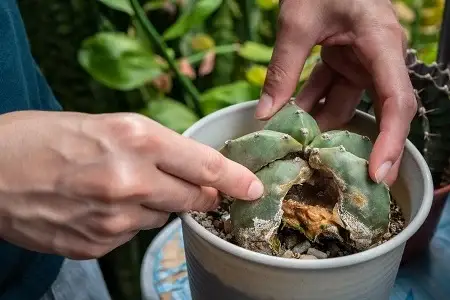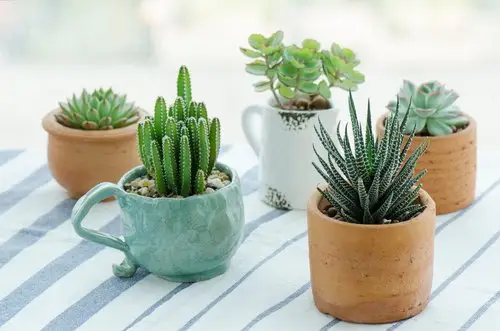Common Cactus Plant Diseases and Pests and How to Fight Them

Cacti, those prickly wonders of the plant world, has captured the imagination of gardeners and nature lovers worldwide. Their striking appearance, resilience, and adaptability have made them popular additions to gardens, homes, and office spaces. However, cacti face unique challenges beneath their tough exterior, primarily in diseases and pests. We will delve into the world of cactus plants, uncovering the allure that draws people to them and understanding the vital importance of managing and combatting cactus plant diseases and pests. So, let’s embark on this journey to explore the captivating realm of cacti and learn how to protect these remarkable plants.
Understanding the Impact
As captivating as cacti may be, it’s crucial to recognize the consequences of turning a blind eye to cactus diseases and pests. The impact can extend beyond the health of these resilient plants and even pose risks to humans. Let’s dive into the potential repercussions:
Consequences of Ignoring Cactus Plant Diseases and Pests
When cactus plant diseases and pests are left unaddressed, they can wreak havoc on your cherished plants. Here’s what you need to know:
- Diminished Beauty: Neglected cacti can lose their vitality and visual appeal. Unsightly spots, blemishes, and withered pads can mar the aesthetics of your garden or indoor space.
- Reduced Lifespan: Pests and diseases can shorten the lifespan of your cactus. Over time, if not treated, the plant may succumb to the relentless assault, leading to irreversible damage.
- Spread to Others: Infected or infested cacti can spread diseases and pests to nearby plants, endangering your entire plant collection. Prevention and early intervention are vital to protecting your garden.
Risks Associated with Cactus Diseases in Humans
While cactus diseases primarily affect the plants themselves, some diseases can pose risks to humans:
- Skin Irritation: Handling infected cacti or contacting certain cactus species can lead to skin irritation. Spines, glochids, and the sap of some cacti can cause discomfort and allergic reactions.
- Respiratory Issues: Inhaling airborne particles from infected cacti may trigger respiratory problems, especially in individuals with preexisting conditions or sensitivities.
- Allergies: Some people may develop allergies to cactus spines or substances released by diseased cacti, leading to itching, rashes, or other allergic reactions.
Identifying Cactus Plant Diseases and Pests
Cactus Plant Diseases: Causes and Symptoms
Despite their hardy reputation, Cacti are susceptible to various diseases that can threaten their well-being. Understanding the causes and symptoms of these diseases is essential for effective plant care.
- Root Rot: This common cactus ailment is often caused by overwatering, leading to fungal growth in the roots. Symptoms include wilting, discoloured and mushy roots and a general plant health decline.
- Fungal Infections: Cacti can fall victim to fungal diseases like powdery mildew or botrytis. Look for telltale signs like white, fine spots on the plant’s surface or blackened, decaying areas.
Spotlight: Prickly Pear Cactus Diseases
Prickly pears, a popular type of cactus, have their diseases to contend with. Keeping an eye on these diseases is crucial for the health of your prickly pear cacti.
- Cochineal Scale Infestation: The cochineal scale insect often targets Prickly pear cacti, which feed on their sap, causing damage and discolouration. Look for white, cotton-like masses on the cactus pads.
Cactus Plant Pests
Cacti has its fair share of unwanted visitors. Identifying these pests is the first step in preserving your cactus’s beauty and vitality.
- Spider Mites: These tiny arachnids may go unnoticed until they’ve caused significant harm. Look for stippling on the cactus’s surface and fine webbing between its spines.
- Aphids: Aphids can congregate on cacti, sucking sap from their tender growth tips. These pests are often found in clusters and can cause stunted growth and distortion.
How to Get Rid of Cactus Bugs
Dealing with cactus pests requires a proactive approach to protect your beloved plants.
- Pruning: Trim-affected cactus parts to remove damaged areas and pests.
- Natural Predators: Encourage beneficial insects like ladybugs or lacewings to help control pest populations.
- Insecticidal Soap: Use a mild insecticidal soap to wash away pests from your cacti.
Prevention and Management
Now that we’ve delved into cactus plant diseases and pests, it’s time to equip ourselves with the tools to combat these challenges effectively. Prevention and management are crucial aspects of cactus care, ensuring the health and longevity of these fascinating plants.
Identifying the Right Cactus Diseases Treatment
Cacti can fall ill like any other living organism, but the good news is that many diseases can be treated. Identifying the disease afflicting your cactus is the first step towards successful treatment. Here’s how to go about it:
- Visual Inspection: Sift through your cactus for unusual symptoms such as spots, discolouration, or wilting. Note any changes in growth patterns.
- Research: Consult reputable resources or seek expert advice to pinpoint the disease based on the observed symptoms.
- Appropriate Treatment: Once identified, choose the proper treatment method. Depending on the disease, this may involve pruning affected parts, using fungicides, or adjusting watering practices.
Best Practices for Preventing Cactus Diseases
Prevention is often the most effective strategy when it comes to cactus diseases. Here are some best practices to keep your cacti disease-free:
- Proper Watering: Overwatering is a common cause of cactus diseases. Ensure your cacti receive the right amount of water by allowing the soil to dry between waterings.
- Well-Draining Soil: Plant your cacti in well-draining soil to prevent soggy roots and fungal growth.
- Quarantine New Additions: Isolate newly acquired cacti for a few weeks to ensure they are free from diseases or pests before introducing them to your existing collection.
Cactus Plant Pest Control
Protecting your cacti from pests requires a proactive approach. Here are some effective strategies:
- Regular Inspection: Routinely inspect your cacti for signs of pests like spider mites or aphids. Early detection can make pest control more manageable.
- Natural Predators: Encourage beneficial insects such as ladybugs or parasitic wasps to help keep pest populations in check.
- Pruning and Isolation: If you identify an infested plant, promptly isolate it to prevent the spread of pests. Pruning affected areas can also aid in control.
Sustainable Approaches for Pest Management
Consider adopting sustainable and eco-friendly pest management practices for your cacti:
- Neem Oil: Neem oil is a natural and non-toxic solution for controlling pests. Dilute it and apply it to your cacti to deter unwanted visitors.
- Companion Planting: Planting cacti alongside pest-repelling herbs or flowers can help prevent pests.
- Biological Controls: Introduce natural predators like nematodes to your soil to combat soil-dwelling pests.
Succulent Pests and Diseases
Succulents, like cacti, have a unique allure that has captivated gardeners and plant enthusiasts alike. These water-retaining wonders come in various shapes and sizes, making them perfect companions to cacti in your garden. However, succulents are not immune to their own set of pests and diseases.
The Connection Between Cacti and Succulent Pests and Diseases
Succulents and cacti often share the same environments and growing conditions, making them susceptible to similar challenges. Here’s how they’re connected:
- Common Enemies: Many pests that target cacti, such as spider mites and aphids, also have a taste for succulents. These unwelcome guests can quickly spread from one plant to another if not controlled.
- Disease Cross-Contamination: Fungal diseases that affect cacti can also harm your succulents. The proximity of these plants to your garden can lead to cross-contamination if proper precautions are not taken.
How to Protect Your Entire Succulent Collection
Now that we understand the link between cacti and succulents when it comes to pests and diseases, it’s essential to take steps to protect your entire succulent collection:
- Isolation: If you identify pests or diseases on one plant, isolate it from the others immediately to prevent further spread.
- Quarantine New Additions: Just as you would with cacti, quarantine newly acquired succulents before integrating them into your collection to ensure they are not carrying any hidden issues.
- Regular Inspections: Consistently inspect your succulents for signs of trouble. Early detection can make it easier to address problems swiftly.
- Appropriate Care: Ensure your succulents receive the right amount of sunlight, water, and well-draining soil. Healthy succulents are better equipped to fend off pests and diseases.
Expert Tips and Tricks 
Achieving a flourishing and stunning cactus garden can be rewarding for cactus enthusiasts. To help you on your journey to becoming a cactus fan, we’ve gathered some expert advice and tips to ensure your cacti survive and thrive in your care. Let’s dive into these valuable insights:
- Light is Key:
Cacti are sun lovers, so ensure they receive ample sunlight. Place them in a sunny spot, preferably with direct sunlight, for several hours daily. Rotate your pots occasionally to promote even growth.
- Mindful Watering:
Overwatering is one of the most common mistakes made by cactus enthusiasts. Water your cacti sparingly and allow the soil to dry out completely between waterings. Use a well-draining cactus mix to prevent soggy roots.
- Choose the Right Pot:
Opt for pots with drainage holes to prevent excess moisture buildup. Terracotta pots are an excellent choice for better air circulation and moisture evaporation.
- Watch the Temperature:
Cacti thrive in warm temperatures but can tolerate more excellent conditions in the winter. However, protecting them from frost is crucial, as extreme cold can harm their health.
- Minimal Fertilization:
Cacti have low nutrient requirements. Fertilize sparingly, typically during the growing season (spring and summer), using a diluted, balanced fertilizer.
- Pruning and Grooming:
Regularly inspect your cacti for dead or damaged growth and remove it with clean, sharp tools. This encourages healthy new growth and prevents disease.
- Pest Vigilance:
Keep a close eye on your cacti for signs of pests. Early detection is essential for effective pest control. If you spot any unwanted visitors, take swift action to address the issue.
- Respect Their Space:
Give your cacti ample room to grow. Proper spacing allows for better air circulation and reduces the risk of disease and pest infestations.
- Seasonal Adjustments:
Be mindful of seasonal changes in light and temperature. Adjust your care routine accordingly to provide the best conditions for your cacti throughout the year.
- Share the Love:
Join cactus enthusiast groups or forums to exchange knowledge and experiences with fellow enthusiasts. You can learn valuable tips and tricks from others who share your passion.
The Bottom Line
In the captivating realm of cacti, we’ve embarked on a journey to understand the unique challenges these prickly wonders face. We’ve explored the importance of proactive care, the consequences of ignoring cactus plant diseases and pests, and the need to safeguard your cacti and succulent collection. Along the way, we’ve gathered expert tips and tricks to help you nurture a thriving and beautiful cactus garden.
Your cacti are not just plants but living, breathing wonders of nature. They will continue to thrive with your care and attention, bringing unique beauty and charm to your home or garden. So, let’s take action, protect these captivating plants, and keep our cactus gardens thriving for years.










